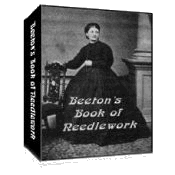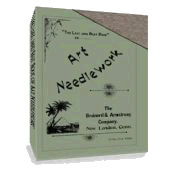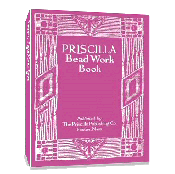Single or Double Thread?
That is an interesting and common question!
It is sometimes confusing on whether to use a single or double thread when embroidering. Here is some information that Victorian ladies were given when this question arose. You will find the information just as pertinent now as it was then.
"Filo" was a type of silk embroidery thread, therefore, to make it relevant to you, you will need to think in terms of what you are using such as embroidery floss, silk, etc.
Single or Double Threads.
Embroidery Lessons with colored Studies, 1899, Brainerd & Armstrong Co.
It is often the case that two threads of the Filo can be used in the needle with better results than a single thread, and an embroiderer who understands when it is proper to resort to the use of the so-called "double thread" can give to her work a richness which would be lacking if she confined herself exclusively to a single thread.
The rule which governs the use of the single or double thread is derived from the general principle, that the lighter and more delicate the figure or fabric, the finer should be the thread. It is, therefore, proper to use a double thread when the figure to be embroidered is large or the material heavy. In such cases, the whole flower or leaf is sometimes completed with the double thread, but more often the double thread is continued nearly to the center, and the "shading in" is done with a single thread.
The advantage gained from such a use of the "double thread" is apparent in the increased richness and weight of the work. It can, therefore, be taken as a safe rule, in embroidering good sized flowers or in working upon heavy material with Filo, that the outer portions of the petals and foliage should be done with a double thread, and the shading in towards the center, with a single thread.
But this rule does not apply to small flowers or delicate materials, which should be worked with a single thread on the edge and throughout the whole embroidery. The use of two threads anywhere in such delicate designs would give a clumsy and unwieldly look to the work, and, indeed, even a single thread sometimes seems too clumsy for such work and it is necessary to split it for shading the centers.
It is always possible to experiment with a design on a separate piece of linen and to soon determine whether it is better to use a double, single or split thread.
Another important thing is to thread the needle correctly. It is not proper, when it is desired to use a double thread, to double a single strand in the needle, as the twist will run in opposite directions and cause the silk to be roughened. The correct way is to pull two strands out of the skein together. The two strands will naturally cling together and they can be easily threaded into the needle.
Believe it or not, this information was printed in every Embroidery Lessons by Brainerd & Armstrong printed from 1899 to 1912! (Those are the ones I own - it could have run longer.) They obviously felt that every embroiderer would have this question and felt the information was good enough to keep publishing year after year.
Whether to use a single or double thread is still a questions every embroiderer asks her/himself at one time or another. Experience will allow one to almost instinctively know which to use but there are time when even a seasoned embroiderer will have to experiment to find the answer. Following the above information will help any embroider to accomplish a project of which one can be proud.
Return to top of Single or Double Thread page.
Return to Hand Embroidery page.
The Last and Best Book of Art Needlework
Over 100 pages of authentic Victorian instructions and patterns from 1895!
FREE
Beeton's Book Of Needlework

433 pages!
Sign up for VEAC! Everything you wanted to know about Victorian embroidery, needlework, crafts and more!
Priscilla Bead Work Book
Make Beautiful Victorian Beaded Purses, Jewelry & Accessories - Starting
TODAY!



